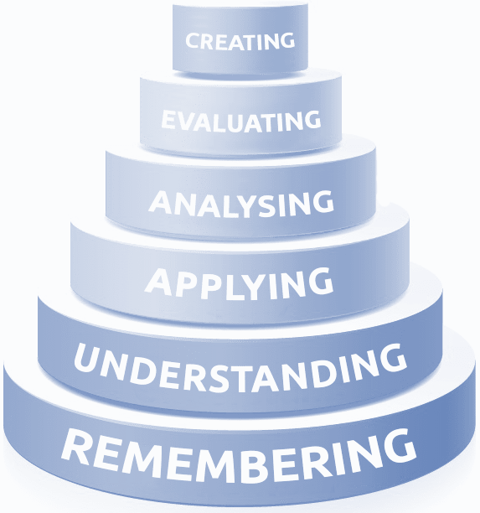Bloom's Taxonomy
Bloom's taxonomy is a set of hierarchical models used to classify educational learning objectives into levels of complexity and specificity. The taxonomy is a hierarchical ordering of cognitive skills that can help teachers teach and students learn.
Although named after Bloom, the publication of Taxonomy of Educational Objectives followed a series of conferences from 1949 to 1953, which were designed to improve communication between educators on the design of curricula and examinations. In the 2001 revised edition of Bloom's taxonomy, the levels were slightly adapted.

- Remembering involves
- recognizing facts, terms, basic concepts or answers
- in the approximate form in which they were learned
Level 1 verbes: Define, duplicate, list, memorise, formulate, repeat, retrieve, recognise, recall, reproduce. - Understanding involves
- recognizing facts, terms, basic concepts or answers
- in the approximate form in which they were learned.
Level 2 verbes: Interpret, exemplify, classify, summarise, infer, compare, explain, paraphrase, discuss. - Applying involves
- solving problems in new situations
- by applying acquired knowledge, facts, techniques & rules
- with a minimum of direction
Level 3 verbes: Demonstrate, interpret, solve, use/execute, illustrate, convert, discover, discuss, prepare. - Analysis involves
- examining and breaking information
- into component parts
- determining how the parts relate to one another
- identifying motives or causes
- making inferences, and
- finding evidence to support generalizations.
Level 4 verbes: Compare, contract, criticise, differentiate, discriminate, organise, question, distinguish, experiment. - Evaluating involves
- presenting and defending opinions
- by making judgments about information, the validity of ideas, or quality of work
- based on a set of criteria or a standard.
Level 5 verbes: Appraise, argue, judge, select, support, evaluate, debate, criticise, measure, select, test, verify. - Creating vinvolves
- originating, integrating and combining ideas for
- building a structure, a pattern or a plan
- from diverse elements.
Level 6 verbes: Assemble, generate, construct, design, develop, formulate, rearrange, rewrite, organise, devise.
Bloom’s taxonomy is a powerful tool to help develop learning objectives because it explains the process of learning:
- Before you can understand a concept, you must remember it.
- To apply a concept you must first understand it.
- In order to evaluate a process, you must have analyzed it.
- To create an accurate conclusion, you must have completed a thorough evaluation.



 Patrick Soenen: +32 477 75 78 61 - Monique Garsoux: +32 472 73 98 36
Patrick Soenen: +32 477 75 78 61 - Monique Garsoux: +32 472 73 98 36 info[at]qap.eu
info[at]qap.eu